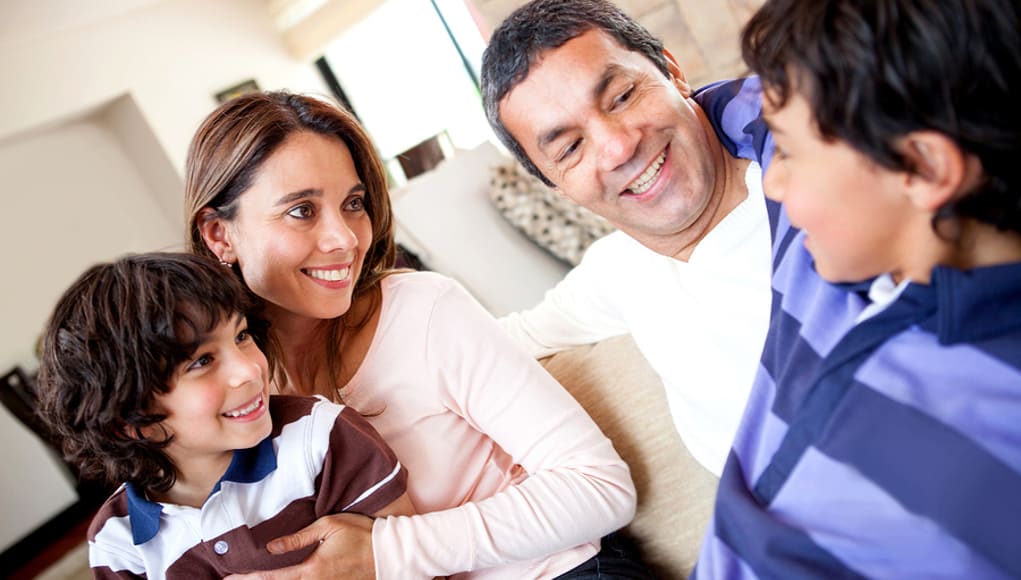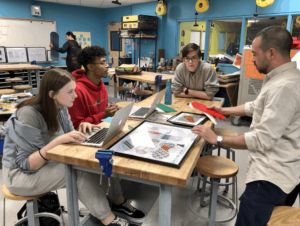Small Talk, Big Benefits: Adding Conversations to Reading and Everyday Moments

By: Erin Gohl & Kristen Thorson
All parents want to do what is best for their kids. Fulfilling that aspiration is often challenging and unclear for even the most well-meaning parents given the many variables that affect children, families, and everyday life. However, there are a few axioms that research and practice have told us are unequivocally good for our children. We know we should feed them healthy foods like fruits and vegetables; We know that a good night’s sleep is critical for a growing child; and we absolutely know that reading with our children is uniquely valuable.
Regular exposure to reading and books has a plethora of benefits for children: Reading expands exposure to language and new vocabulary; it builds foundational skills such as prediction, sequencing, and summarizing; and it introduces characters and worlds far beyond a child’s family or neighborhood. In short, reading is really powerful for kids.
In recent years, there has been a flowering of research that hones in on steps parents can take to make reading with their kids even more meaningful. If parents engage in dialogic reading, or conversation-based reading, they can both broaden and deepen the already wonderful benefits of the reading experience.
What is Dialogic Reading?
Dialogic reading is based on the word dialogue and describes having two-way conversations with kids while reading. This is done by having back and forth conversations. It is fundamentally different from broadcast reading, which is simply reading the words in a book to a child. This is also distinct from the practice of asking closed questions that have yes, no, or a right or wrong answer. Dialogic reading promotes the use of open-ended questions to create these conversations while reading. In this dynamic, the child and the caregiver contribute to the conversation in equal parts.
Research: Two-Way Conversation with Kids “Turbocharges Their Brains”
Research from a broad spectrum of disciplines including neuroscience, early childhood, education, and psychology have consistently shown that dialogic reading has tremendous academic and social emotional benefits. Studies have shown that these two-way conversations build language and literacy skills, create a structure for communication and dialogue, and increase parent capacity for engaging with children around learning. Key points from this research tell us:
Dialogic reading stimulates the cognitive development of young children. This 2017 study shows the powerful benefits of dialogic reading. The research describes the effects of having conversations with kids while reading as “turbocharging” kids’ brains. When participating in conversation-based reading, the study found that children were more engaged in the narrative and that key portions of the brain were activated.
There are benefits of parent-child shared reading interventions for children AND their parents. This meta-analysis published by the American Academy of Pediatrics shows that Parent-Child Book Reading (PCBR) interventions “are positively and significantly beneficial to the psychosocial functioning of both children and parents.” Shared reading improves parent capacity, parent and child attitudes toward reading, and the quality of the familial relationship. The study found that these reading experiences may also reduce stress levels of the participating parents.
Dialogic reading has an impact on literacy for at-risk students. This article details the research showing that dialogic reading is proven to boost at-risk children’s oral vocabulary skills and argues that its use “is one potential way to help children avoid […] later reading failure.”
The benefits of having conversations with young children extend beyond reading. A recent study in the journal Pediatrics shows astoundingly higher language skills, measured a decade later, for kids who have frequent conversations with parents when young. The authors found that promoting conversations in the home can bring equity to and mitigate socioeconomic-correlated disparities in literacy development.
Family Tips for Fostering Conversations
As children grow and develop, the dynamics of these conversations change and evolve. When conversing with babies, adults can model the cadence of conversations by speaking and leaving pauses for a response. You might mimic the sounds they make and the words they say, and connect their language to the people, places, and things in the world around them. When talking with toddlers or preschoolers, conversations can become more balanced as their vocabulary and language usage grow. Use their words, phrases, and experiences as springboards for deeper conversation. When engaging with school-aged kids, invite them to truly be partners in conversation. It may take some kids more time to respond, so be sure to create space and pauses for them to gather their thoughts. And when they initiate conversations about an interest of their own, promote the behavior by actively participating.
Across all ages, these conversations can be easily integrated into current reading habits and embedded within everyday life moments:
While Reading: Books provide an ideal onramp to high-quality conversation. Before reading, take time to investigate the title and image on the cover. Ask your child what they think the story might be about and why, and share your own predictions and thinking. While reading, notice how characters are feeling and why they might be feeling that way. Share together if you have experienced similar situations or emotions. After reading, discuss ways the book relates to your own experiences. Encourage discussions of more global issues beyond the text. This analysis both reinforces their comprehension of the book and extends their understanding.
On a Walk or In the Car: While you are out on a walk or driving in the car, there are limitless opportunities for conversation. Talk about what you see—from the animal crossing the road to the changing of the seasons—and ask each other questions. For example, if you see a construction zone, talk about what you think is being built. Why are they building that type of structure in that area? How are the construction workers working together? These types of conversations help children to connect to their community and their world.
At a Store: Use conversation to make mundane tasks more meaningful and enjoyable. While completing your weekly grocery run, use the items that surround you to inspire conversation. You might brainstorm together what you can make with certain ingredients. When you see an exotic fruit, you might speculate together on how it would taste and whether you would like it. And for the youngest shoppers, model conversation by simply describing each item you add to your cart and asking their thoughts on the items.
Preparing for an Adventure: Any outing or activity can be an exciting adventure. As you get ready to head to a new playground or park, brainstorm what equipment you might see. Ask and share details of your dream playground, and explain why you would choose each structure. If you are heading out of town, share with one another what you know about the destination, discuss what you are most excited about and why, and talk about what will be the same as your home and what will be different. These two-way conversations build excitement, quell anxieties, and deepen and enrich your child’s ability to think creatively and critically.
Adding Conversation, Building Literacy, Increasing Joy
The research is clear—engaging in two-way conversations is incredibly beneficial for children, regardless of age, gender, race, or socioeconomic status. Rooting these conversations in reading and books, the studies show, furthers these benefits and also increases the development of foundational literacy skills while fostering an overall positive attitude toward reading.
But, the benefits of this kind of shared reading far transcend the metrics of scientific studies. Giving children room to express their opinions and feelings empowers them to regularly use their voice. It teaches them that their thoughts and opinions matter and gives them a model for how to effectively share them. These conversations allow for connections to be built between the content of a book and a family’s personal history and background. This kind of dialogue fortifies channels of communication that extend beyond reading and create a space for productive conversations among families about personal and global issues and challenges. And the very best part of having high-quality conversations with your child, where you share interesting details about one another, when you heartily laugh together over a funny moment, and when you genuinely connect with each other after a long day, is that it feels really joyful. So remember, stop and smell the roses. And talk about it.
For more, see:
- Early Childhood: What We Know, and What’s Possible
- Why Early Childhood Education Matters Now More Than Ever
- 20 Ways to Celebrate National Family Literacy Day
Stay in-the-know with innovations in learning by signing up for the weekly Smart Update.






Morrison Paul
Nice post! I like it